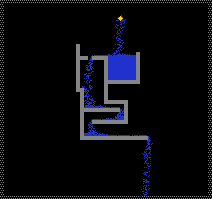Difference between revisions of "Element:WATR"
nothing123 (talk | contribs) (Just some minor knowledge added. As well as some info organizing.) |
m |
||
| Line 44: | Line 44: | ||
'''Spawn temperature:''' +22.00 ''Celsius'' \ 295.15 ''Kelvin''. | '''Spawn temperature:''' +22.00 ''Celsius'' \ 295.15 ''Kelvin''. | ||
| − | Hex triplet colour: # | + | Hex triplet colour: #2030D0 (mild light blue). |
Revision as of 05:06, 30 March 2020
 Conducts electricity, freezes, and extinguishes fires. | |
| Properties | |
|---|---|
| Section | Liquids |
| Spawn temperature | 20°C |
| Heat Conductivity | 11.6% |
| Relative weight | 30 |
| Gravity | 0.1 |
| Acid dissolve rate | 2% |
| Flammability | 0 |
| State | Liquid |
| Transitions | |
| Low temperature |
|
| High temperature |
|
| Misc properties | |
| Conducts electricity (SPRK) | |
| Allows neutrons to pass through | |
| Source code | |
Contents
 Water
Water
Description: "Conducts electricity, freezes, and extinguishes fires."
Spawn temperature: +22.00 Celsius \ 295.15 Kelvin.
Hex triplet colour: #2030D0 (mild light blue).
Element properties
Water evaporates to water vapour at temperatures ≥ [+99.86 + 2P] C \ [373.01 + 2P] K .
Water freezes to ice or snow, both of ctype WATR, if at temperatures ≤ than -0.01 C \ 273.14 K, into ice if the pressure is ≤ +0.79, or snow if the pressure is ≥ +0.80.
General information
Is a product of distilled water and most powders and liquids, with a slow but existent capacity to conduct electricity.
Ignites (solid) rubidium and liquid rubidium if in contact with them, but also extinguishes fire.
Distilled water will turn to water if other water is in contact with it. Similarly, water will turn to saltwater if in contact with it.
Neutron reactions
Water becomes distilled water if bombarded with neutrons.
Neutrons will travel in water and convert water to distilled water, but will be slowed down and eventually it will either get terminated by the water or (if present) materials that absorb neutrons.
Known water reactions
Some water reactions:
Other element reactions involving water:
Some reactions that create water:
| Language: | [[::Element:WATR|English]] |
|---|
| Language: | [[::Element:WATR|English]] |
|---|